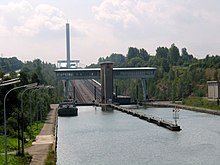Charleroi-Brussels Canal
The Charleroi – Brussels Canal is a shipping canal in Belgium that connects the cities of Charleroi and Brussels . The current canal is 74 kilometers long.
history


As early as 1531, Charles V approved the construction of a canal that was to connect the Scheldt at Willebroek to Charleroi via Brussels. However, construction did not begin until 1550 by order of Maria of Hungary , then governor of the Netherlands. In 1561, however, construction stopped after reaching Brussels.
With the industrial revolution , however, there was renewed interest in continuing the canal, as there were large coal deposits in the area around Charleroi. The earthworks for the construction of the Charleroi – Brussels Canal began on April 2, 1827, and the foundation stone for the La-Bête-Refaite tunnel was laid on August 1 (length: 1,267 meters, width: 3 meters). Although the work was delayed by the events of 1830 ( Belgium's struggle for independence ) and shortly afterwards by lack of money, the canal was inaugurated on September 22, 1832.
The canal was initially only built with a relatively small cross-section and was only suitable for 70-ton ships. That is why the expansion work began shortly afterwards. From 1854 to 1914, the work was advanced to the point that 300-ton ships could operate between Charleroi and Clabecq .
After the First World War , work could be resumed. This time the aim was to expand the Clabecq – Brussels section for 1,350-ton ships. The idea of making Charleroi accessible for 1,350-ton ships arose after the Second World War due to increased transports to Antwerp .
course
The most important structure on the canal is the Ronquières ship lift , which is constructed in the form of an inclined elevator . A height difference of 68 meters is overcome over a length of a good 1400 meters. The ships are moved in a water-filled trough. The elevator has two independent troughs.


